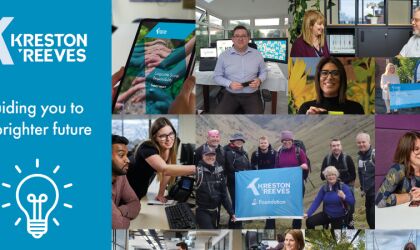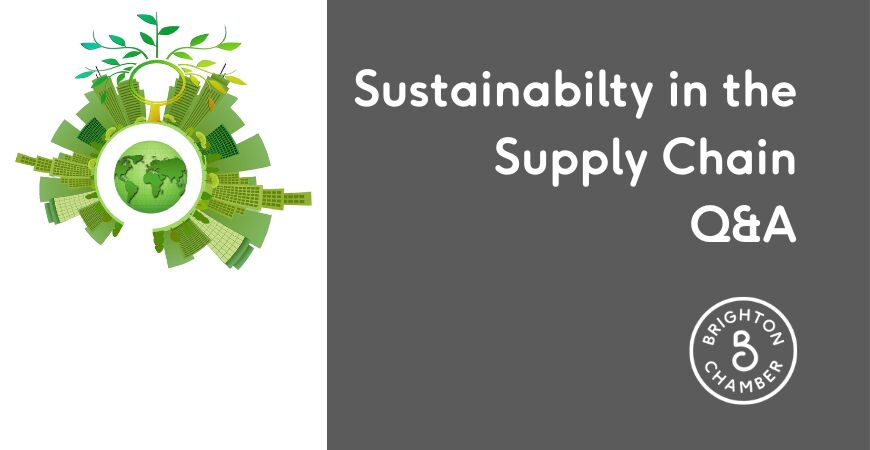

Fri 07 / 10 / 22
Q&A: Net Zero and sustainability in the supply chain
Frank Hyde writes up the main takeaways from our Q&A with Lucy Walsh, founder of B Sussed, on becoming Net Zero and sustainability in the supply chain.
By Frank Hyde of Brighton Chamber
Sustainability is becoming increasingly important in business, but reducing your emissions can seem like a very overwhelming task. Lucy Walsh of B Sussed answers all your questions on how to approach Net Zero, with a focus on addressing sustainability in the supply chain and scope three emissions.
Brought to you in partnership with Shoreham Port's sustainability week.
What are the different types emissions?
The approach to Net Zero essentially considers three types of emissions.
Scope one is direct emissions resulting from on-site energy, such as gas boilers and fuel for company vehicles. Importantly, this includes all greenhouse gases, not just carbon, and so it also involves things like refrigeration equipment which can leak greenhouse gases.
Scope two is indirect primary emissions, such as your purchased electricity, heat, cooling, and steam.
Scope three is basically everything else, formally defined as any indirect emissions resulting from your supply chain. For many companies, this accounts for 80-90% of overall emissions, and is therefore one of the most challenging yet important considerations for getting to Net Zero.
What about offsetting?
This is the process of becoming Carbon Neutral by calculating and compensating for your emissions through paying into an offsetting fund. Programmes like Ecologi, which plant trees to compensate for carbon emissions, are a good start but are not enough in the long run. Clearly, we need to reduce emissions as well.
Net Zero takes this further, requiring you to reduce those emissions by up to 80% or as far as possible, prior to offsetting any remaining emissions.
Does software like Ecologi Zero make a difference?
Ecologi Zero is a tool that is being launched soon which links with accounts software to analyse scope three emissions and allow them to be identified, reduced, and offset. This is a great first step for companies to address their emissions.
There are also plenty of companies, like Plan A, that provide carbon calculators to help companies assess scope three emissions. How far in depth you go with using software in assessing your emissions really depends on the resources you have available for the process.
How can I prioritise scope three reporting and set up a Sustainable Procurement Plan?
An easy way of beginning to consider your scope three emissions is to ask yourself:
Where do I spend the most money? What’s the largest quantity of things that I buy?
Basing your initial analysis off your financial accounting is a simple way to find your “big hitters” and a feasible starting point for the process. This extends to both upstream and downstream supply chains.
As a company, you need to be clear about the key focuses within your Sustainable Procurement Plan and how you are prioritising them. Establish the environmental and social standards that you will expect your suppliers to comply with and be transparent about how you will check that with them.
Also, think about the things you are getting, and whether you need all of it - or even need it at all! Often, some of the most effective changes can be made by considering small, unquestioned things. Take company pens as an example - are they necessary? As a product, it consumes resources to make but provides very little advantage to your business.
How can I account for emissions resulting from employees working from home?
Homeworking emissions are an important consideration in scope three. A common assumption is that working from home reduces emissions due to a reduction in commuting, but this is not necessarily the case. In Brighton for example, very few people drive to work – preferring instead to cycle or take public transport. For some businesses, homeworking will actually increase emissions as employees are using more energy in heating and lighting their homes in comparison to a single office space, especially as winter approaches.
EcoAct have produced a whitepaper, which can be found on the Chamber Net Zero page, which gives you the methodology and average values to account for homeworking emissions. This is great if you’re considering large numbers of employees who work from home, but sometimes it might be worthwhile to get more specific and accurate information from your employees. This extends to freelancers and other indirect employees – ask them about their workspace and their travel.
What can I do to help employees to reduce emissions?
There are many steps you can take as a business to help your employees understand and reduce their emissions. Lots of companies now are providing energy efficiency training for their employees, looking at emissions both in the office and at home.
Some actions you can take might be as simple as providing a dedicated area for cyclists to dry clothes in the office, to encourage sustainable transport, or providing better facilities to encourage recycling and reduce waste. A bit further up the chain would be to review the energy efficiency of your office equipment, including laptops being used for homeworking. It's important to be transparent about your efforts and why you're doing it - make sure your employees feel like they are a part of the journey.
How do I encourage my supply chain to address their emissions?
Your ability to influence your supply chain will obviously depend on your size and resources. But, there are some questions you can ask which help to identify the ‘environmental hot spots’:
- Do they report on their emissions?
- Can they provide you with their results?
- If not, do they have the raw data you'd need to calculate it for them?
- Do they have any plans to address environmental impact in the future?
- Do their internal policies consider emissions?
It's important to motivate and encourage your suppliers, rather than leave them behind. Let them know what you need from them, and how they can provide it. Perhaps you can offer them the templates you used to calculate your emissions, or share your experience of best practice.
It’s important to remember that we’re all in this together, and working together is the best way to reach Net Zero as quickly and efficiently as possible.
How do I start?
Trying to take simple steps is important – there’s a lot going on and it’s easy to get caught up in the enormity of it all. As long as you’re transparent about how you’ve selected what you’re looking at now, and what you’re going to look at in the future, that’s a perfectly accepted way to get going.
There are lots of things you can calculate, but it’s important to remember that the goal is not just to calculate but to reduce as well. If you have an output with emissions that are going to be really hard to reduce, then it may be more important to focus on something where you can have a directly successful interaction with reducing emissions.
Think about how best to use your time and resources, and where your problem areas are. Once you start looking at the major things, you’ll understand the process better and over time will be able to embed it in your activities. To start with, maybe pick just five suppliers or five aspects of your business. Review your progress with them, alongside your values and policies, and learn from it.
The University of Oxford have a detailed procurement strategy which considers environmental impact, as well as the questionnaire which they sent their suppliers in order to obtain the information. Though it would need adapting to your needs, this would be a good starting point for your own business. The Corporate Disclosure Platform also contains a multitude of case studies which can be scaled down and adapted.
Is going green financially good for business?
There are multiple ways it can help financially. Your business is inherently part of the supply chain, so when the people who you supply products and services to begin to consider their environmental impact, you'll be expected to keep up.
Investment processes consider ESG, and that helps you to obtain and retain clients. It’s also important to remain attractive to potential employees – lots of the younger generation want their employers to demonstrate their proactivity with regards to climate impact. There’s also regulations and legislation. Although it’s focused on large companies for now, it will soon extend to smaller companies, and it’s good to stay ahead of the curve.
While going Net Zero is a time and resource investment at the moment, it’s rationalised by the long-term benefits for both company and the environment.
If you want to contribute to the Chamber blog, contact us on hannah@brightonchamber.co.uk



